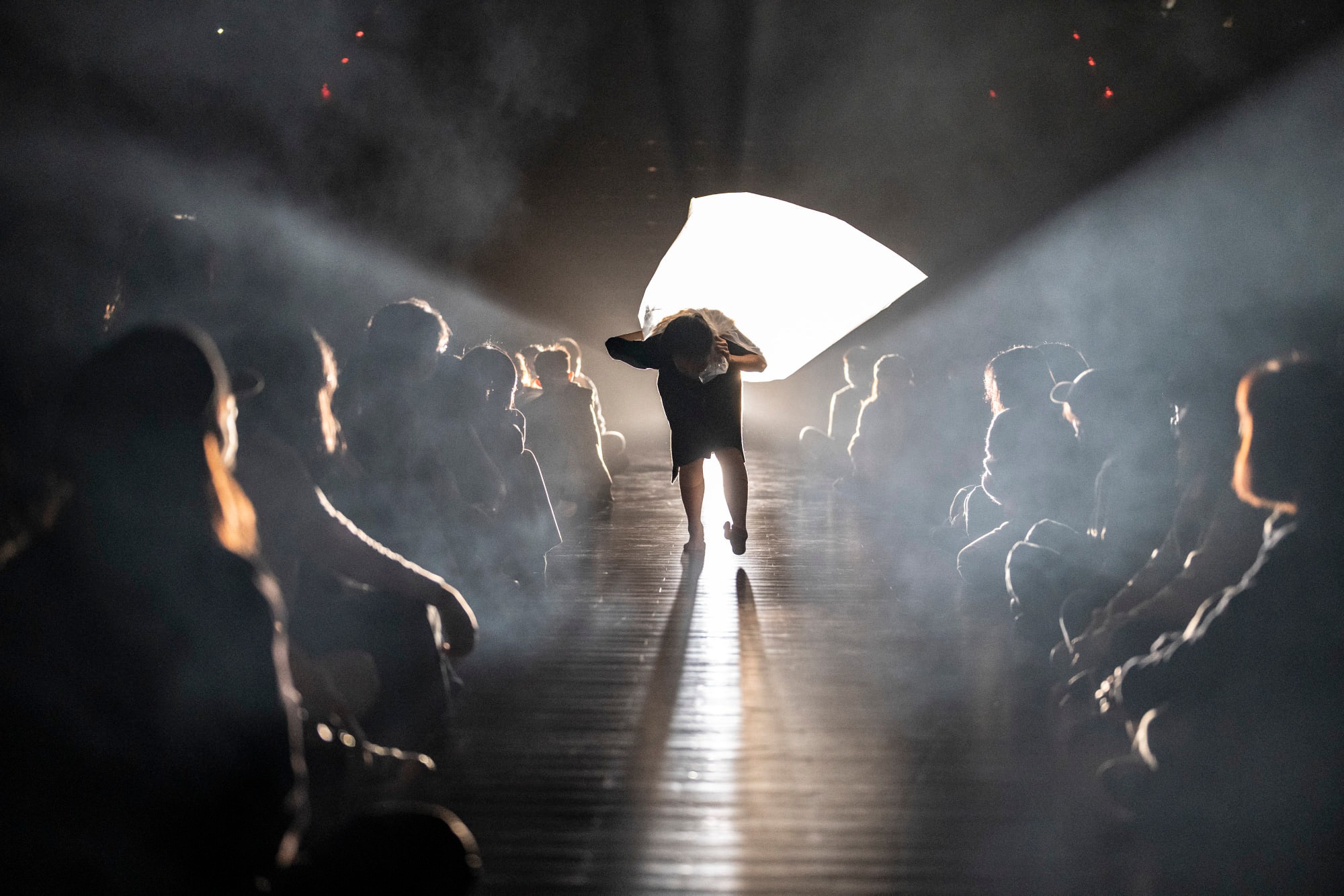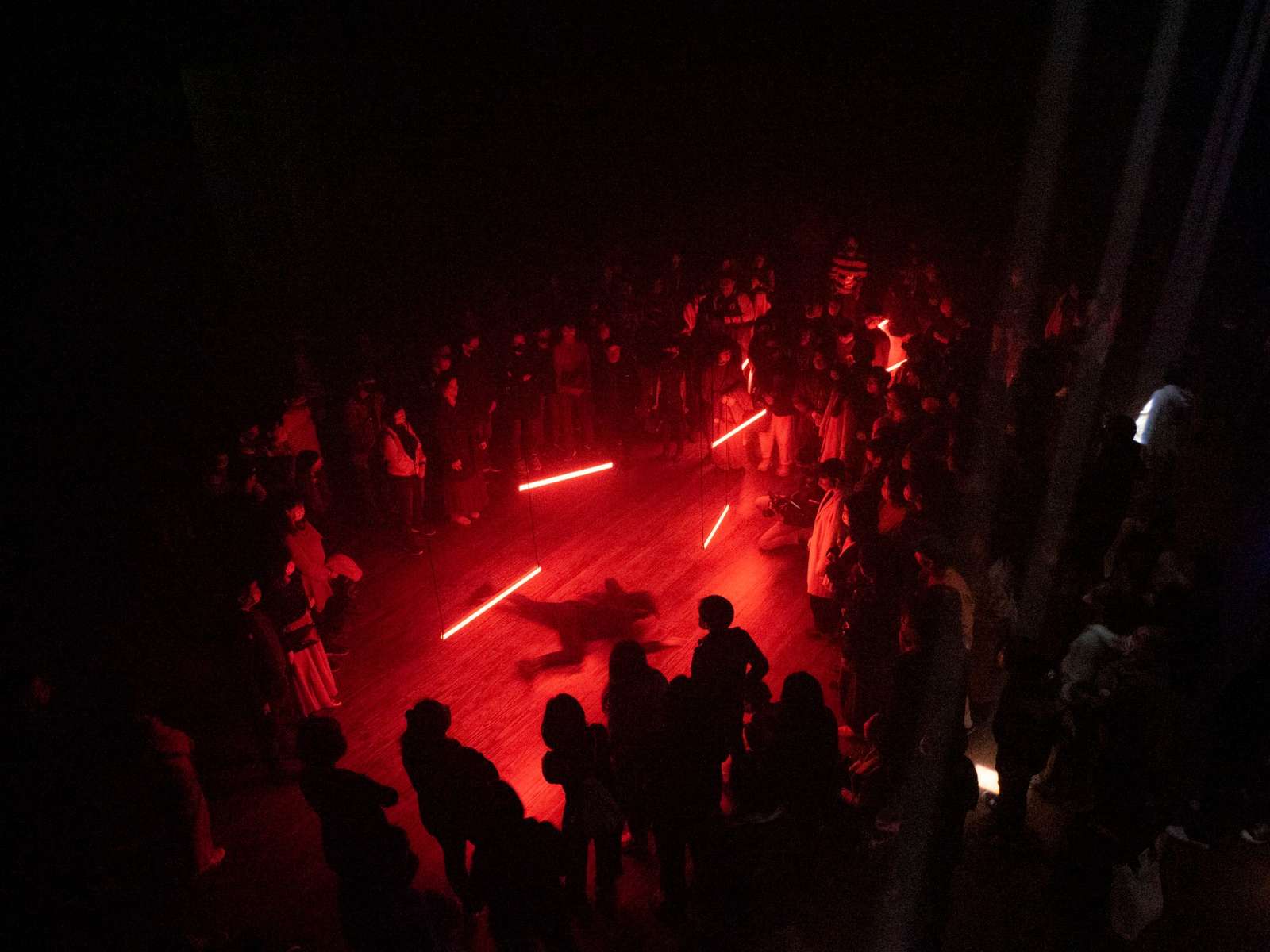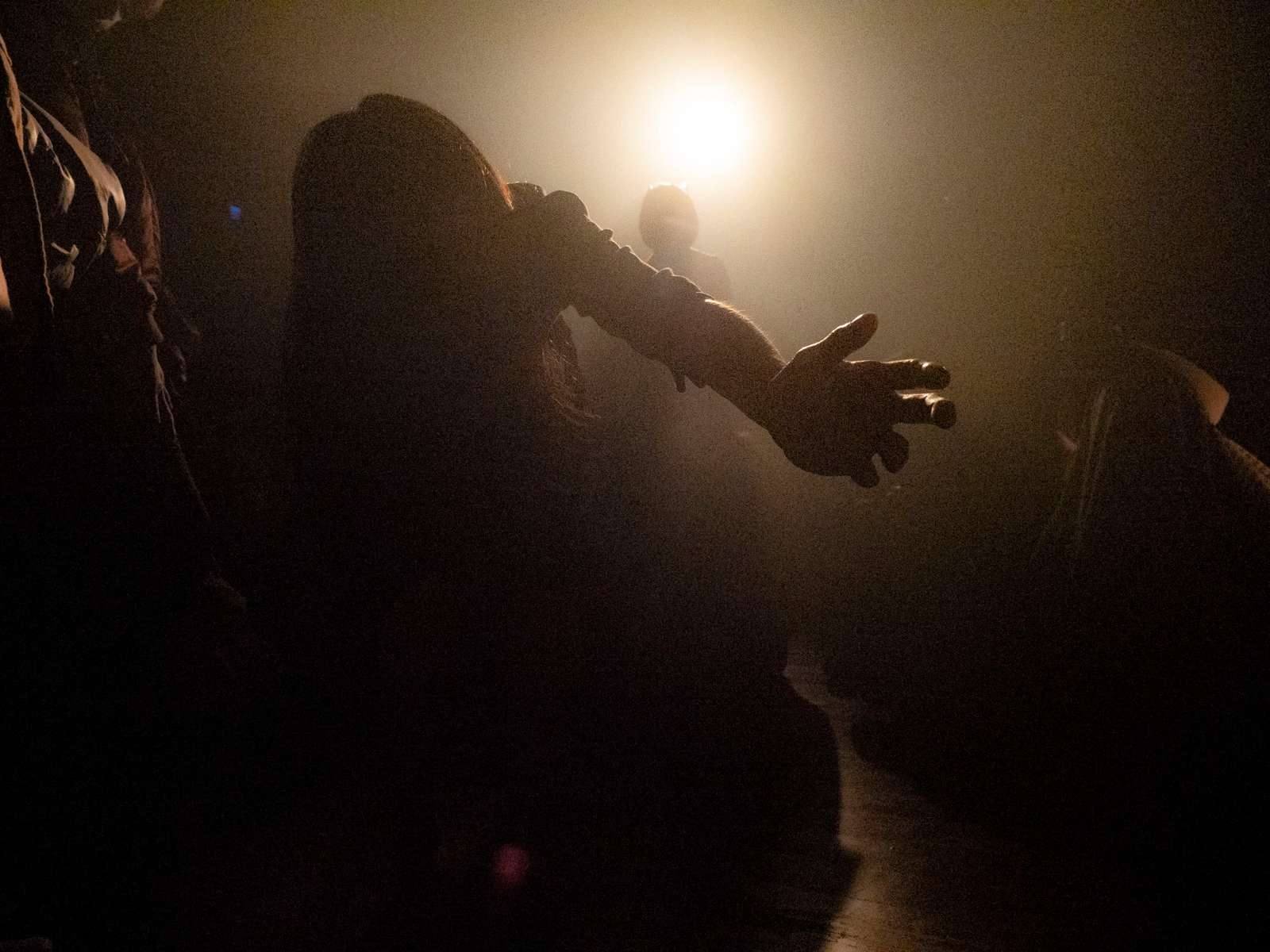
What Makes Us Rise Up? Art and Movement
Trans|張新
A dancer enters a dark space from the back and cuts through the crowd sitting on the ground. The dancer seems to carry something heavy on her back, and the crowd makes way for the dancer to come slowly forward. Soon, a dazzling whirlwind of body gestures. The crowd begins to merge with the dance; we are no longer gazing at a proscenium stage from our individual positions but transformed into a dancing, contagious human flow. As the dancer glides through the spectators and brings chaos along her way, we are lost in the middle of a storm, bumping accidentally into each other, relocating, not knowing where to look or where to go. As if falling in love, we become nervous, sweaty, vertiginous, and uncertain, fretting and enjoying this contradictory tension as our presupposed body positions lose any sense of relevance.
The revival of Wang Shi-Wei's Masses at Cloud Gate Theater in 2021 has rekindled a desire to revisit the relationship between art and movement. What are we in this relationship? By what means do we become the masses? How do we prevent the masses from turning into a homogenized collective while maintaining their inner selves? What are the affective forces that mobilize the masses? And what is the relationship between art and movement?
Works about the relationship between “art and movement” always encounter the contradiction between aesthetics and social reality. Is it the artists that co-opt the movement (in order to realize their individual aesthetics by exploiting the movement)? Or is art only an instrument for social change (social change is more important than art)? [1]The popular belief in the incompatibility of art and movement has discouraged artists from direct social intervention despite their strong sense of social awareness, as they are wary about the risks of inadvertently exploiting social movements by reducing their irreducible sensibility into rigid “art forms.”

"Media Representation" and "Live Intensity"
To me, the most important question is not whether we are exploiting social movements but how artists might “transform them,” overcome their simplistic "media representation," and “increase its intensity” (instead of decreasing it) in their artworks. Let us recall the time of the protests in Hong Kong and the brutal images of the protests we witness on social media every day back then: water cannons, smoke, masks, head injuries, symbols of impassionate accusations. Although these images are able to convey the situation in Hong Kong to us through the media, they also diminish the intensity at the actual locations. When we regard the pain of others, the circulation of harrowing photographs of suppression supplants our corporeal perception with the gaze. Our bodies are gradually paralyzed by this sort of sensational media coverage and we are at once infuriated and powerless.
The nervous running and hiding, the constant fear of getting caught, the accidental gatherings, the beating of the heart — these sensations are difficult to convey in full through the media. Consumerist television channels show an endless stream of bloody, shocking news stories, only to follow them up quickly with ads, which seems to suggest that we should take these events more lightly. In contrast, art offers a space unlike that of the media, providing more comprehensive contexts that also shape the events themselves, mobilizing space, light, sound, smoke, and the viewer’s movement to lead us out of our shells and immerse us in the actual situation.

The Alternative Intervention of Aesthetics
Of course, some might think that I think too highly of art. From their perspectives, art is merely produced by the bourgeoisie for their visual enjoyment, a cultural taste constructed by the elites, and the collusion of the structure of power. Discourses on aesthetics have been so exhaustively deconstructed to the point that the concept itself seems to have become a derogatory term of pedantry and conservativeness (compared to the radicality of action). Nevertheless, art does indeed provide us with an “autonomous region” in which we can reflect on, criticize, and expand our perceptual experiences. The tradition of “aesthetic disinterestedness” since Kant likewise aims at emancipation and freedom. Although the notion of aesthetic autonomy is currently seen as a status symbol of the bourgeoisie, since activists believe that social intervention through action is the better path to change society, actions such as revolution, play, intervention, and reformulation are in fact inseparable from the concept of “aesthetic autonomy.”
Aesthetic autonomy is not a symbol of taste; it is more about reshaping the perception, the opposition to oppression, and the aspiration for freedom. Aesthetic autonomy is not the consolidation of personal taste (personal branding and art fairs, among other things, use individuality as their selling point), nor the diminution of individuals in the name of collective action; instead, it aims to forcefully reclaim the “public,” produce of “new assemblies,” and shape “alternative masses” in a time of privatization and individualism.
Aesthetics is an alternative form of intervention. Unlike the teleological concept of “instrumentality” (how humans are determined by the social fabric), the accidental, aesthetic assemblages, like love, change the status quo. In these assemblages, the masses are no longer homogenous and led from top to bottom; instead, they are “multiple masses” in which our “inner experiences” are transformed into “public experiences.”
Aesthetics is no longer focused on self-indulgent personal happiness (which reinforces individualism, I'm so lonely), nor the rational consensus of public discourse (often emphasizing the discursive logic and rejecting all sorts of irrational noises). It is, instead, a kind of collective experience that is "both personal and public," "within and without," in which the subject is no longer a fixed position, but a belligerent, mixed, and fluid becoming-subject interdependent with others.
The Experience of Interwovenness, Ecology of Equality, and Unpredictability in Masses
As we come back to Masses, we might, for a moment, bypass the relationship between social issues and civil movement, because pursuing this topic could easily lead to the one-sided condemnation of state hegemony and thus subordinate the work to the social issues at hand (which is what many criticize as "art taking advantage of social issues"). Furthermore, although Masses seems to "have recreated the scenes of protest on the streets of Hong Kong" in the theater by employing imageries and effects such as swirling smoke, clamoring voices, symbols of protest, and black clothes, this is not all that there is. More importantly, we must take a closer look at the "operative approach of the work," or, in other words, how it "makes use of the masses."
First, there is the relationship between the collective and the individual. Given that only a single dancer, the choreographer Tien Hsiao-Tzu, is seen throughout the entire performance, is it correct to proclaim that the dancer represents the masses of protesters? Of course not! The masses are not what the media represents, but an intense inner experience. It is not the medial gaze of the subject-object binary, but an infiltrating, ecological, and reciprocal experience.
Second, since there is a solo performance, is the dancer, therefore, the protagonist of the dance? The answer is likewise no! As is with the Hong Kong protests, here we are also dealing with a “decentralized” operation. Besides the audience and the dancer both functioning as “the masses,” who form a duet with their body gestures, it is, more importantly, the “inanimate masses” — the sound, light, smoke, umbrellas, masks, black clothes, descending light tubes, and various objects on stage — that act as both co-participants of the performance as well as agents. We should not restrict the masses only to the “dancer-spectator” humans, but must also take into consideration the organic, ecological network created together by the objects and the masses. Hence, it is this “ecological network” that is the true protagonist of the piece.
Third, is the drive, body infection, and osmosis of the ecological network only a stance against “the sense of alienated distance”? As a matter of fact, the spectators are not forced to move; they can, instead, also choose to “remain where they are” and refuse to assist or support the dancer as she falls, grasps, and stumbles during the course of the performance; they can maintain their reason and regard other’s pains from a distance, or even decide to hold their ground during the opening scene during which the dancer directly walks through the audience and force her to make a detour. This relationship between “immersive participation” and “detached observation” likewise echoes real-life protest situations, where some observe the scenes from afar and others directly and enthusiastically take part in the action. And most importantly, the performance is not entirely controlled by the director: the audience functions as the main factor of uncertainty. Everything hangs in the balance, and the audience is bestowed with a great amount of liberty to interfere with the dancer’s choreographed movements.

What Makes Us Rise Up?
The experiential, equal, and serendipitous nature of the work evokes a sense of playfulness. The masses are not a homogeneous crowd controlled from the top; instead, it is a fluid network that is decentralized, accidental, randomly converging, and full of life. Most importantly, Masses engages critically with the “medium of theater” and its original function as festival and assembly. If we take a look back, we can see that theater originally served as assembly; it not only offered a space for people to watch performances (thus becoming “spectacles”) but also created an “alternative public space” through the expansion of its affective influence (which is not pre-determined, but interventional, accidental, and unpredictable).
In the last scene of Masses, the dancer opens the window to let the "outside world" into the "fictional theater," releasing the tension of the depressive, suffocating, tense, and shifting sensory stimulations, while also leaving room for the audience to reflect on the impassionate intensity they've just witnessed. In addition, the show also ends without a curtain call, signaling the fact that social movements "never truly come to an end." To conclude, I would like to quote the inspiring words by the art historian Georges Didi-Huberman from his book To Desire, To Disobey: What Makes Us Rise Up:
To rise up? First, to pick up one's fear, no doubt. To throw it away. Or even to throw it directly in the face of those who draw their power from organizing our fears. To throw it away, but also to spread this very gesture. To give it, through this, a political sense. It is to have aroused one’s desire. It is to have seized it — and with it its expansive joy — in order to throw it in the air, so that it extends into the space we breathe, the space of others, and the entire public and political space. [2]
Masses successfully rejects the discourse-centered didacticism and the reductionism of visual media and transforms the “audience of visual observation” into “masses of physical participation” by means of our bodies, gestures, and ambience. Bodies collide in the theater space. We conjure up gestures of revolution, resistance, vulnerability, and pain from our muscle memories buried deep within our bodies, releasing these gestures from the corporeal confines of today’s system of privatization (the affective control of the media). As aesthetics reshapes our depleted desires and exerts radical force, we are allowed to develop alternative desires and passions once again; we dance like Bacchus, the god of wine, and we are equal like water, like beasts, like everything, like the universe, like chaos — like, Mi Mi Mew Mew.
Notes
[1] Since Mi Mi Mew Mew underlines the apposition of hybridity and paradox instead of that of mutual exclusion, it detests the binary logic of mutual exclusion between "art" and "society."
[2] 迪迪-于貝爾曼(Georges Didi-Huberman)(陳旻 譯),〈慾望所致:何以讓我們揭竿起義〉,《新美術》第2期(2018):39-104。
All images in this article are courtesy of Dynamo Management. Photographer: Liu Chen-Hsiang.
「現象書寫-視覺藝評」專案贊助單位:財團法人國家文化藝術基金會、文心藝術基金會